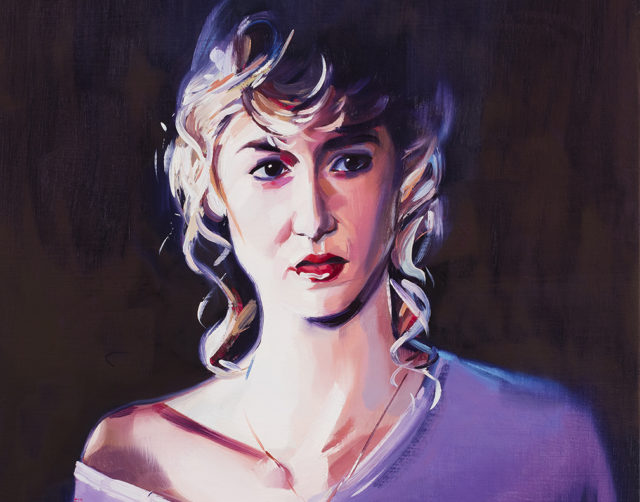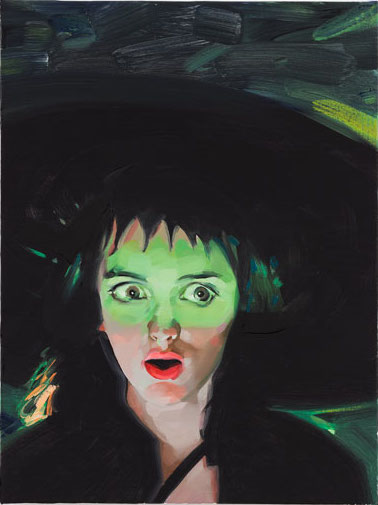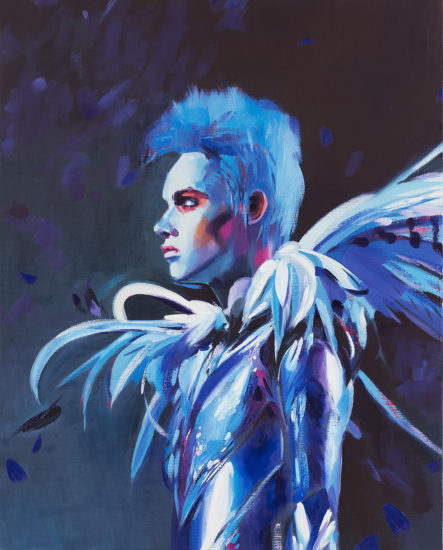
Detail of Sam McKinniss’ Sandy, 2016, oil, acrylic and aqua leaf on canvas (Courtesy the artist and team (gallery, inc))
Sam McKinniss: Egyptian Violet
team (gallery, inc.)
83 Grand Street
New York, NY
On view until November 12, 2016
Some exhibitions raise more questions than they answer. Take Sam McKinniss’ current show Egyptian Violet at team (gallery, inc.), which presents a sense of unease and potential for violence in his fan boy paintings of celebrities and movie characters. The subject matter is thoughtfully curated and carefully painted and yet, it is still difficult to pin down McKinniss’ exact critique. Is it a general representation of our anxiety-ridden era in 2016? A statement, à la A.L. Steiner’s 30 Days of Mo:)rning, about how everything is going wrong at once? A critique of the vacuity of pop culture? A death obsession? Or is there no real social critique at all? I left the show with no clear answer.
The first of many clues that lead to a web of possible interpretations comes from the exhibition’s title. It derives from the name of a purple paint color that McKinniss employs in every painting. With so much of one color, the paintings, hung around the one-room gallery space, create a band of purple. Ranging from Winona Ryder as the moody Goth girl Lydia in Beetlejuice and Michelle Pfeiffer licking herself as Catwoman in Batman Returns, the fourteen paintings are variously sized with seemingly no relation to the importance of the subject. (He shrinks Whitney Houston down to 12 x 9 inch canvas while he devotes one of the three large-scale canvases to a swan, which is depicted quite regally in purple shadow.

Sam McKinniss, Lydia, 2015, oil and aqua leaf on canvas (Courtesy the artist and team (gallery, inc))
This shade imbues each subject from Snoop Dogg to Whitney Houston and Flipper (the 1990’s reboot version) with a dark luminescence that resembles black light posters. It goes without saying that the works have a healthy dose of kitsch. But, they also engage their subjects with a nuanced depiction of violence–even if its social commentary is vague. Violet recalls a range of references from flowers to the color of bruises. Historically, shades of purple like lavender and mauve have long been associated with homosexuality. This violet symbolism is certainly not lost on McKinniss who also represents several queer icons and figures in the show. This includes the painting of the character and queer sex symbol Brian Slade, played by Jonathan Rhys Meyers in Todd Haynes’ glam rock Velvet Goldmine. The painting looks like an ode to Slade’s gender-bending, over-the-top aesthetic with the carefully rendered feathers on his jumpsuit.
For viewers with some knowledge of the film, the painting takes on a more complicated and elusive meaning. It represents the moment Slade looks out to the crowd before he is shot onstage. His onstage murder is a sham in the film–a ploy to rid himself of his Ziggy Stardust-esque personae. But, the painting seems as if Slade is staring down death–or at least the death of his alter ego. Is this a statement on violence against queer individuals, a representation of the complexity of identity or just, a painterly adoration of an androgynous rock star?

Sam McKinniss, Brian Slade, 2016, oil and acrylic on canvas (Courtesy the artist and team (gallery, inc))
McKinniss’ choice to paint these mostly well-known figures, culled from online image searches, could be brushed off as the tired impulse to drag nostalgic low culture into the high art gallery arena. And getting pop culture nostalgia right is tricky. Artists run the risk of making art that looks like looks like it belongs in a Buzzfeed listicle or tacky mass-produced paintings of celebrities found at a mall kiosk. In this respect, the show shouldn’t work.
But, because the paintings repeatedly call to mind the subject of death, while the exhibition may falter, it never fails. Take, for example, Prince, which is the first painting viewers see when entering the gallery–mostly due to its sheer size. The central painting features Prince from the cover of his album Purple Rain. One of three large-scale paintings in the show, Prince is a straightforward and sincere representation of the iconic album. The painting is admittedly campy with Prince’s ruffled outfit and come-hither stare on his motorcycle. That is more Prince’s own doing than McKinniss’ artistic intent.

Sam McKinniss, Prince, 2016, oil and acrylic on canvas (Courtesy the artist and team (gallery, inc))
Viewed in the context of Prince’s recent death, however, the painting becomes an unavoidable representation of celebrity mortality (and immortality). In an interview with Bill Powers in ArtNews, McKinniss revealed that he started the painting the day after the news broke about Prince’s passing. His somewhat ghoulish drive to paint the late singer, as well as the staggering enormity of the canvas, gives the painting an almost religious bent. Equating big paintings with religious icons is certainly nothing new. But coupled with the album cover’s campiness, I have to wonder if McKinniss means to poke fun at both the reverence given to the late singer and monumental blue chip paintings. No matter his intent, the painting becomes a portrait of the unique phenomenon of celebrity death as much as portrait of Prince. It’s actually creepy.
Even when not representing dead pop stars, the portraits in Egyptian Violet maintain a simmering unease and discomfort as seen in Sandy. While it’ll likely be overlooked by the more in-your-face spectacle of Prince, the smaller painting Sandy perhaps best exemplifies the overarching theme of violence in the show. Sandy features Laura Dern’s girl next door character from David Lynch’s disturbing and demented psychosexual cult classic Blue Velvet. In the film, Sandy gets caught in the violent world of Frank Booth (Dennis Hopper) and Dorothy Vallens (Isabella Rossellini) with the similarly naïve Kyle MacLachlan’s Jeffrey Beaumont.
Here, Sandy stands in a fuzzy purple sweater with her brow furrowed and mouth open with worry. With her blond hair falling over her forehead, she looks like an innocent high schooler thrown into darkness, which is emphasized by the almost black background McKinniss paints around her. Like the cut-off ear found in the white-picket fenced neighborhood in beginning of the film, the painting represents the fear of cruelty hidden within in the seemingly innocuous everyday. Viewers don’t know what Sandy is looking at. Likewise, this air of anxiety running through the show has no tangible source or definable commentary. But it still casts its shadow and feels mysteriously pertinent.
All of which brings me back to my original question about what McKinniss hopes to communicate with these paintings. Even without a comprehensible position, the show’s free-floating dread remains remarkably relatable in late 2016. And yet, he seems to similarly refuse to reveal his actual self–or critique. Does this matter? Should he rely so heavily on the on viewers’ own contextualization of the works in the current culture? I pose these questions, not to propose a set of responses, but to say that after extended viewing and a day and a half of writing, I am still unsure of the answer.


Comments on this entry are closed.